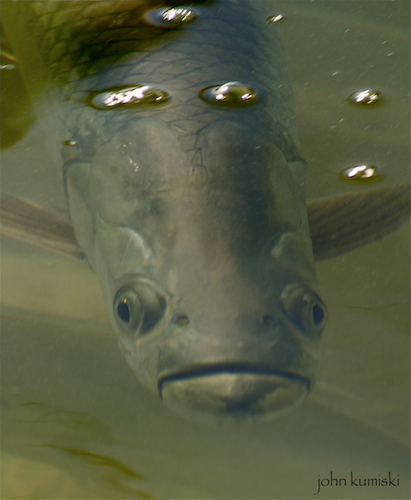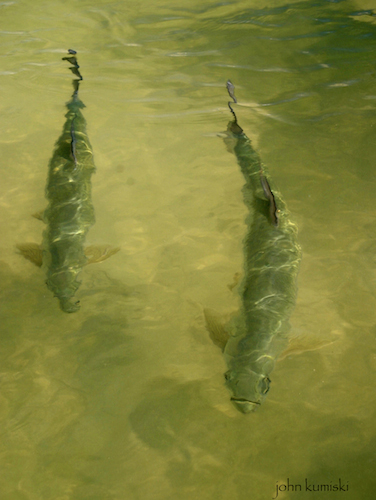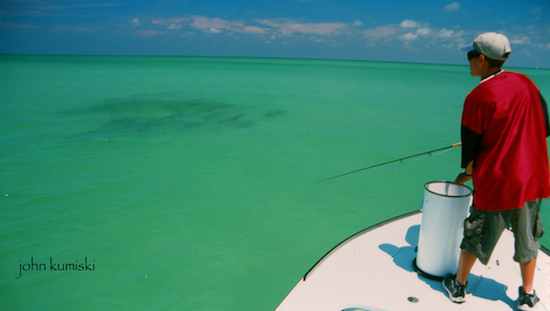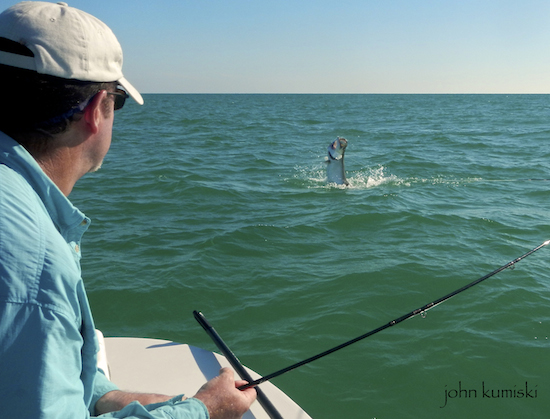Tarpon Fly Presentation
It was a tarpon fisher’s dream, a school of at least 200 fish, tightly wadded up, slinking over each other, finning out, flashing, real relaxed, real happy, one of the finest sights in all of angling. Harry Kant was trembling with excitement. He’d been trying for 11 seasons to take a hundred pounder on fly. If he made a good tarpon fly presentation it was practically certain that the deed would now be done.
“Cast out in front of them, and retrieve just fast enough to keep in contact with the fly,” I told him. Harry, an excellent caster, ignored me completely, casting right across the middle of the school and stripping hard back through them. The fish weren’t quite as relaxed now.
“Don’t do that, you’re scaring them,” I said. “Lead them, put it where they’re going and let them swim into it.” Harry cast right across the school and stripped it hard through them again.
“Harry, don’t cast it across them, it’s spooking them. And strip it slower, you’re going too fast!”
Harry turned to me and stated in a tone that squelched any further discussion, “I don’t like to strip slow.” So I shut up and stayed with the fish while he cast over them time and time again, stripping hard, and not getting bit.
Harry finally turned to me and said, “I don’t have any faith in this fly.” “Give me your rod, and find a different fly in the stretcher box,” I said. While he looked for the magic fly, I took two casts at the fish. On the second a big fat fish ate the fly right by the boat, jumped immediately, almost landed on the gunwale, and soaked Harry with water. The fish, thrashing wildly, hopped off on its third jump. I handed the rod back to Harry and said, “It’s not the fly Harry, it’s you.”
—–
There are two morals to this story. The first is, take your guide’s advice. The second, and the one we’ll deal with here for the rest of this piece, is that after locating the fish, how you present the fly to them is the single most important variable in getting one to bite, even more important than what’s at the end of your leader.
Tarpon Fly Presentation- The Strike Zone
When I was younger and just getting into the tarpon game, I was fortunate to get a copy of the finest instructional fishing video ever made, Billy Pate’s Fly Fishing for Tarpon (which I recommend highly). In this video Billy explains the concept of strike zones as it relates to tarpon fishing. We’re going to revisit this concept and then relate it to presenting the fly to cruising fish, laid-up fish, and fish in daisy chains.
The strike zone is an area around the fish where, if the fly is properly presented, you have a reasonable chance that the fish will take it. This area is roughly shaped like a half a football, extending with the wide part at the mouth of the fish to the apex out in front of it. Since their mouths point up, tarpon prefer to feed going up, so in their case the strike zone might be a little above their line of travel. Understand that this zone changes in size constantly though, going from non-existent to huge and back again, and occasionally even goes behind the fish. Over the years I’ve seen two fish do about faces to take a fly. It’s rare, but it does happen. Our assumption here is that in order to get a bite, the fly must be in the strike zone.
Hopefully it’s obvious that the longer the fly is in that strike zone, the more likely the fish is to take it. This brings us to presentation angles.
Tarpon Fly Presentation- Presentation Angles for Cruising Fish
You could be positioned in front of the fish, with him swimming directly at you. You could be behind the fish, with him swimming directly away from you. You might be off to the side of the path of the fish, with your cast at a right angle to his line of movement. Or you might be somewhere in between one of these three locations. Where is the sweetest place to be?
The longer you can keep the fly in the strike zone, the more likely you are to get a bite. The place from which you can keep the fly in the strike zone for the longest amount of time is directly in the path of the fish, with him coming right at you. You can adjust the speed of your retrieve to keep the fly a foot in front of him, or, if it’s a school, in front of a lot of them. This is by far your best chance.
As you get closer to being at a right angle to the path of the fish the sweetness of the angle declines, since the fly of necessity is in the strike zone for a shorter amount of time. Cruising tarpon move about ten feet per second, so at a 90 degree angle your fly might be in front of the fish only a second or two.
By the way, do not make the mistake of casting past the fish and bringing the fly to it. Tarpon are not used to being attacked by their prey, and unless you’ve watched it happen you’d be astonished at just how spooked a group of tarpon can be by a three inch long fly. If your cast is too long it’s best to wait for the fish to pass and then try again.
As the fish gets past you you’re casting from behind it. You have almost no chance to get a bite. They see the line and leader land, and the fly is coming at them. This is a desperation tactic and only serves to booger up the fish. It’s much better to use the time to collect yourself for the next shot, or to try to get back out in front of them.
Tarpon Fly Presentation- Presentation Angles for Laid Up Fish
I do most of my tarpon fishing along the southwest Florida coast and don’t see too many laid up tarpon there. However, I have fished for them in the Keys and in the Everglades, and everything mentioned above holds true. Actually, it’s easier fishing because the fish is just sitting there. You have much more time to get a good angle and make a good cast.
I was in the Keys backcountry with John Bottko one time, and we found this big fish that was just lying there, apparently asleep. I had the rod, and dropped the fly three feet in front of it. Nothing. I placed the fly two feet in front of it. Nothing. I placed the fly a foot in front of it. Nothing. I laid that fly right at the tip of its nose. Fish don’t have eyelids, but I swear that fish blinked, and then in the most casual way imaginable opened its cavernous mouth and sucked that fly in. What a rush!
What you don’t want to do to a laid up fish is spook it. Start by putting your fly out in front of it a short distance, and if nothing happens cast it closer and closer until you get a response.
Tarpon Fly Presentation- Presentation Angles for Daisy Chains
We may not see lots of laid up fish along the southwest Florida beaches, but we certainly see lots of daisy chains. A daisy chain is a string of tarpon swimming in a circle, nose to tail. They can go either clockwise or counterclockwise, and I’ve seen them with as few as four fish to as many as a couple hundred. They present a wonderful target since you get shot after shot after shot. So, to where do you cast?
In any daisy chain some fish are moving at right angles to you. Others are moving away from you. Others are coming at you. Based on what was said above, hopefully it’s obvious you want to cast to the fish coming at you.
This is another situation where you want to strip as slowly as you can and still keep contact with the fly. When you get it in their face, leave it there! When one fish passes it another will be approaching, so it doesn’t make sense to strip fast. More casts mean more chances to spook the fish.
Tarpon Fly Presentation- Final Thoughts
Understandably, fishermen get excited when they see big tarpon, whether it’s a single fish or a school of hundreds. When the time comes to make the cast, everything about it needs to be second nature. This is no place to be trying to perfect your double haul. Things happen real fast, and you need to be able to respond to opportunities quickly.
You need to be patient when that fish is there, too. One good cast is worth dozens of bad ones. Wait until you have a good angle and be sure you can make the cast before you let it fly.
In general, tarpon don’t feed aggressively. There are exceptions to this, but ordinarily if you want a bite you have to make it as easy as possible for them to eat. Get the fly in their face, and keep it there as long as you can. As soon as it’s out of the strike zone, pick it up and put it back in there. If you do these things you will have success. If you expect the fish to go out of its way to take your fly you’ll usually be disappointed. Make your tarpon fly presentation so that it’s easy for them to eat!
—–
Harry Kant spent two days fishing with me last May. He took my advice this time, had lots of good shots, hooked three fish, and finally, at long last, got that hundred pound tarpon on fly.
I guess sometimes you can teach an old dog new tricks!
John Kumiski
Copyright © John A. Kumiski 2022. It is illegal to reproduce or distribute this work in any manner or medium without written permission from the author, John A. Kumiski, 284 Clearview Road, Chuluota, FL 32766 (407) 977-5207.
If you found this article useful and would like to donate to Spotted Tail, please click here…
![]()




